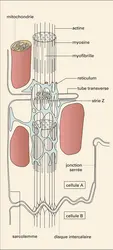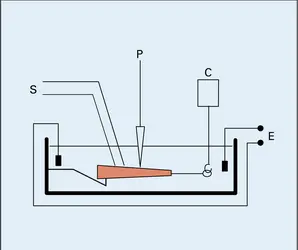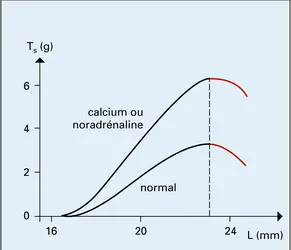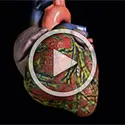MYOCARDE ou MUSCLE CARDIAQUE
Article modifié le
Bibliographie
Physiologie S. A. Briller & H. L. Conn, The Myocardial Cell. Structure, Function and Modification by Cardiac Drugs, Philadelphie (Pa.), 1966
H. F. Brown, « Electrophysiology of the sinoatrial node », in Physiol. Rev., no 62, pp. 505-529, 1982
E. Corabœuf, « Voltage-clamp studies of the slow inward current », in D. P. Zipes, J. C. Bailey et V. Elharrar dir., The Slow Inward Current and Cardiac Arrythmias, pp. 22-95, Martinus Nijhoff, La Haye, 1980
P. F. Cranefield & B. F. Hoffman, Paired Pulse Stimulation of the Heart, New York, 1968
K. H. Dangman, Electrophysiology and Pharmacology of the Heart, M. Dekker, New York, 1991
A. Fabiato, « Myoplasmic free calcium concentration reached during the twitch of an intact isolated cardiac cell and during calcium-induced release of calcium from the sarcoplasmic reticulum of a skinned cardiac cell from the adult rat or rabbit ventricle », in Journ. Gen. Physiol., no 78, pp. 457-497, 1981
Y. M. Gargouïl, « Intérêt des méthodes électrophysiologiques pour l'étude, à l'échelle de la cellule, des propriétés et des modalités d'action des substances pharmacologiques », in Rev. franç. de pharmacie, no 13, 1969
P. Y. Hatt & Y. Grosgogeat, « Ultrastructure myocardique », in Presse médicale, no 78, 1970
C. Kayser, Traité de physiologie, t. III, Paris, 1970
G. A. Langer, « Ion fluxes in cardiac excitation and contraction and their relation to myocardial contractility », in Physiological Review, no 48, Bethesda (D. C.), 1968
M. Masson-Pevet, « The Fine Structure of cardiac pacemaker cells in the sinus node and in tissue culture », thèse, Univ. of Amsterdam, 1979
G. V. Naccarelli, Cardiac Arrhythmias : a Practical Approach, Futura Publ., Mount Kisco (N. Y.), 1991
R. D. Nathan, Cardiac Muscles : The Regulation of Excitation and Contractions, Academic Press, San Diego (Calif.), 1986
D. Noble, « Applications of Hodgkin-Huxley equations to excitable tissues », in Physiological Review, no 46, 1966 ; The Initiation of the Heartbeat, Oxford Univ. Press, 1979
D. Noble & T. Powell, Electrophysiology of Single Cardiac Cells, Academic Press (Calif.), 1987
L. H. Opie, « Role of Cyclic Nucleotides in Heart Metabolism », in Cardiovascular Res., no 16, pp. 483-507, 1982
H. Reuter, « Calcium channel modulation by neurotransmitters, enzymes and drugs », in Nature, no 301, pp. 153-156, 1983
O. Rougier, G. Vassort et al., « Existence and role of a slow inward current during the frog atrial action potential », in Pflügers Archiv für die gesamte Physiologie des Menschen und der Tiere, no 308, Berlin-New York, 1969
R. D. Tanz, F. Kavaler & J. Roberts, Factors Influencing Myocardial Contractility, New York-Londres, 1967
R. W. Tsien, « Calcium channels in excitable cell membranes », in Ann. Rev. Physiol., no 45, pp. 341-358, 1983
C. Wyndham, An Electrophysiological Approach to the Diagnosis of Arrythmias, Futural Publ., Mount Kisco (N. Y.), 1991
E. H. Wood, R. L. Heppner & S. Weidmann, « Inotropic Effects of electric currents », in Circulation Research, no 24, 1969. Pathologie G. Baroldi, F. Camerini & J. F. Goodwin, Advances in Cardiomyopathies, Springer, New York, 1990
H. A. Fozzard et al., The Heart and Cardiovascular System. Scientific Foundations, Raven Press Publ., New York, 1986
K. A. Reimer, R. B. Jennings & A. H. Tatum, « Pathobiology of acute myocardial ischemia : metabolic, functional and ultrastructural studies », in Am. Journ. Cardiol., vol. 52, pp. 72 A-81 A, 1983
T. F. Robinson & R. K. H. Kinne, Cardiac Myocyte Connective Tissue Interactions in health and disease, Karger, Paris, 1990
B. Swynghedauw, « Developmental and functional adaptation of contractile proteins in cardiac and skeletal muscles », in Physiol. Rev., vol. 66, pp. 710-771, 1986
B. Swynghedauw, J. J. Mercadier & J. L. Samuel, « Les Hypertrophies[...]
La suite de cet article est accessible aux abonnés
- Des contenus variés, complets et fiables
- Accessible sur tous les écrans
- Pas de publicité
Déjà abonné ? Se connecter
Écrit par
- Édouard CORABOEUF : professeur à la faculté des sciences d'Orsay
- Didier GARNIER : docteur ès sciences, professeur de physiologie animale à la faculté des sciences de Tours
- Bernard SWYNGHEDAUW : docteur en médecine, ancien interne des Hôpitaux de Paris, directeur de recherche de première classe à l'I.N.S.E.R.M., docteur ès sciences
Classification
Médias
Autres références
-
ANGOR
- Écrit par François BOURNÉRIAS
- 224 mots
Un angor pectoris, ou angine de poitrine, est une manifestation clinique qui traduit une anoxie transitoire du muscle cardiaque.
Le diagnostic se fonde sur la nature des crises, que caractérisent des douleurs rétrosternales survenant typiquement à l'effort, brèves, constrictives....
-
ANTIANGOREUX
- Écrit par Dominique BIDET et Jean-Cyr GAIGNAULT
- 766 mots
Les médicaments qui appartiennent à plusieurs classes chimiques concourant, par des mécanismes parfois multiples, à s'opposer à la crise d'angor, ou angine de poitrine ou coronarite, sont appelés antiangoreux. La coronarite résulte d'une anoxie brutale et transitoire...
-
ANTIARYTHMIQUES
- Écrit par François LHOSTE
- 368 mots
Par définition, les médicaments antiarythmiques sont des substances susceptibles de prévenir ou de réduire un trouble du rythme cardiaque. Ces médicaments sont nombreux, leurs structures biochimiques très différentes, leurs classifications pharmacologiques diverses, mais tous se caractérisent...
-
ATHÉROSCLÉROSE
- Écrit par Loïc CAPRON
- 5 356 mots
- 1 média
...contraintes physiques particulières : courbures, bifurcations, branchements. La manifestation la plus commune est la maladie coronaire ou ischémie du myocarde par athérosclérose coronaire. Les lésions responsables se situent principalement sur les origines et les premiers centimètres des artères coronaires... - Afficher les 18 références
Voir aussi
- ARTÈRES CORONAIRES
- SYSTOLE
- DIASTOLE
- NODAL TISSU
- NŒUD SINUSAL DE KEITH ET FLACK
- ANGIOTENSINE
- ATRIOPEPTINES ou FACTEURS NATRIURÉTIQUES AURICULAIRES (ANF)
- POTENTIEL ÉLECTRIQUE
- ACIDOSE
- PRESSION SANGUINE
- LAPLACE LOIS DE
- INOSITOL TRIPHOSPHATE (IP3)
- MYOGLOBINE
- OREILLETTES
- VENTRICULES
- MYOFIBRILLE
- SARCOLEMME
- SARCOPLASME
- PHYSIOLOGIE
- POTENTIEL DE REPOS
- POTENTIEL D'ACTION
- EXCITABILITÉ
- ATHÉROME
- SODIUM, biologie
- POTASSIUM, biologie
- GRAS MÉTABOLISME DES ACIDES
- JONCTIONS INTERCELLULAIRES
- OXYDORÉDUCTIONS, biologie
- MÉTABOLISME ÉNERGÉTIQUE
- NORADRÉNALINE
- CIRCULATOIRE APPAREIL
- CONTRACTION MUSCULAIRE
- ATPASES (adénosine-tri-phosphatases)
- PERMÉABILITÉ, physiologie cellulaire
- PATCH-CLAMP
- CALCIUM & MÉTABOLISME CELLULAIRE
- ADÉNYLATE CYCLASE ou ADÉNYLCYCLASE ou ADÉNYLYL CYCLASE
- PHOSPHODIESTÉRASES (PDE)
- ADRÉNERGIQUES RÉCEPTEURS
- ALPHA-ADRÉNERGIQUES RÉCEPTEURS
- PACEMAKERS
- CONDUCTANCE, électrophysiologie
- STARLING LOI DE
- BÊTA-ADRÉNERGIQUES RÉCEPTEURS
- CONDUCTION INTRACARDIAQUE
- VOLUME SANGUIN
- RETOUR VEINEUX
- SARCOMÈRE
- REPOLARISATION, physiologie
- FRÉQUENCE CARDIAQUE
- VOLTAGE CLAMP
- AUTOMATISMES, physiologie
- RÉCEPTEURS MEMBRANAIRES
- RÉTICULUM SARCOPLASMIQUE
- STRIÉS MUSCLES
- TROPONINE
- LACTATE
- PROTÉINES G
- RÉCEPTEURS MEMBRANAIRES COUPLÉS AUX PROTÉINES G





